APOLOGETICS 03 - How did the Old Testament come about?
Some Definitions
- The word “Bible” comes from the Greek work “Biblion”, meaning “roll” or “book”, normally a roll of papyrus. This was a general term used for various rolls of books, not especially for Biblical Scriptures.
- The word “Biblion” comes from the Phoenician city of “Byblos”, which produced papyrus scrolls, also called “byblos”
- The word “Canon” comes from the Greek word meaning “measuring rod” or “reed”. “Canon” then means the “standard”, the “reference”, the “authoritative collection of books”.
- The word “Bible Canon” then means those writings that the church fathers agreed as being inspired and authoritative, the 39 books of the Hebrew Scriptures (the Old Testament) and the 27 books of the New Testament.
The uniqueness of the Bible
- God didn’t hang up loudspeakers, send an angel or dictate his Word to a prophet. Jesus didn’t leave one written page behind.
- Rather the Bible is written
- by 40 authors of many different backgrounds
- in 3 different languages (Hebrew, Aramaic, Greek)
- in different literary formats (historical narrative, law, poems, prophecy, letters)
- over 1500 years (1405 BC to 98 AD)
- at the time of the world empires of Assyria, Babylon, Media-Persia, Greece and Rome
- on three continents and in several nations (Israel, Egypt, Iran, Iraq, Turkey, Greece, Italy)
- The Bible is so incredibly varied yet so incredible consistency in thought and revelation, a thing no man could possibly create.
- This consistency is not at the surface. At the surface the different authors deal with very different issues but underneath there is an incredible consistency in the description of the character of God and a Biblical view of the cosmos.
- Whether is is through a passionate love poem, through the searing speeches of the prophets, through the historic records describing Israel or through the concern of an apostle over his young church, it’s the same God, the same view of reality, the same message.
- The claim of the Bible is that God himself spoke his message – through men. The word of God – through men. Men’s words but from God. This is what we call the inspiration of the World of God. The Holy Spirit is inspiring the authors to write what would become the Bible.
- The Bible is the first book that was ever printed, the most printed book in the world and the most translated book in the world.
The Old Testament Canon
- Scripture writing was started by Moses, the first author of a Bible text (Exo 24:4-7).
- Scripture was collected, carefully kept and publicly read from the beginning of the nation of Israel (Deu 31:9-13).
- Also writings after Moses were collected and carefully kept at the tabernacle (Jos 24:25-26, 1 Sam 10:25)
- 450 BC the complete Old Testament canon was collected by Ezra. The book of Malachi was added and since then it is unchanged, Jewish historian Josephus Flavius says.
- The Jews have a great respect for the Scripture, copied it carefully, had an elaborate system of crosschecking to ensure impeccable copying. They never touched the writing, discarded ripped scrolls and buried them respectfully.
- In 1947 AD with the Discovery of the Qumran Caves around 900 ancient scrolls were found, including the entire Old Testament writings (specific prophecies about Jesus included), matching the passed down text exactly.
- Since the Qumran finds the Old Testament is indisputable.
- Pictures: Qumran Caves. Claypots in which the scrolls were stored. Scrolls. Last picture: the famous Isaiah scroll exhibited in the Israel Museum, Jerusalem.

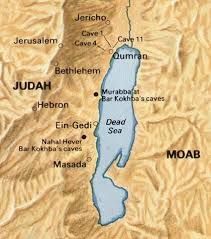
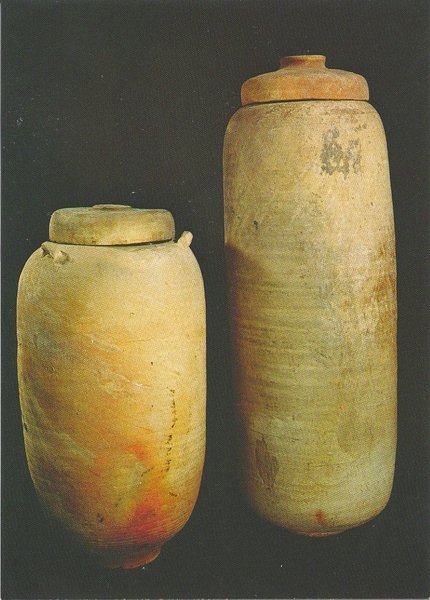

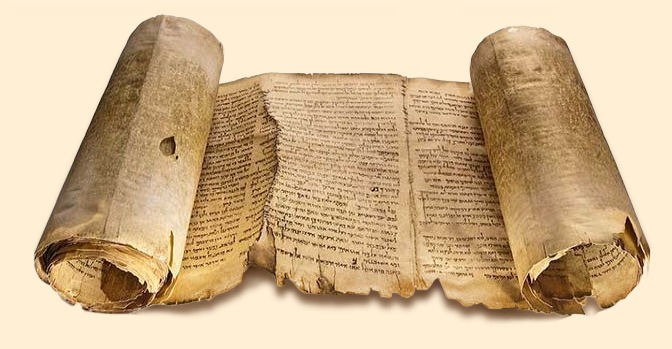
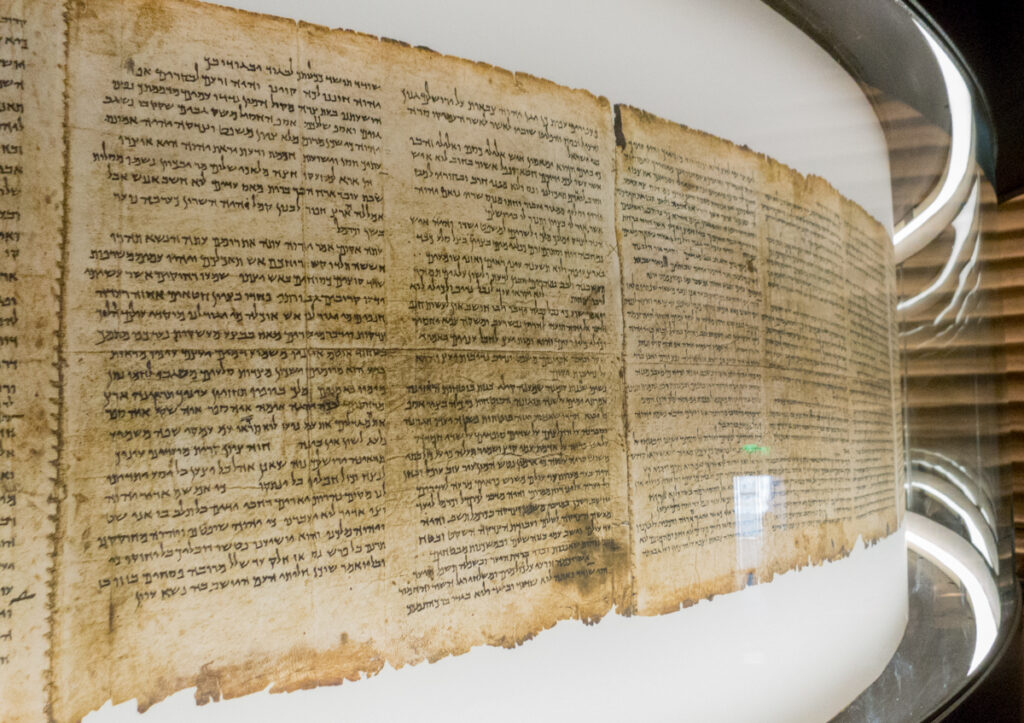
- Jewish Canon has the same 39 books as are in our OT, but the Hebrew Bible is arranged differently (see handout).
- The New Testament writers quote over 300 times from the Old Testament. They refer to it as the “Word of God”, recognizing its inspiration and authority.
- Jesus himself quotes from every Old Testament book except one, thereby authorizing the Old Testament and also the process of canonization.
- The so-called Septuagint (LXX) is a translation of the Hebrew Old Testament into Greek around 250 BC by a committee of 70 Jewish linguists in Alexandria. They re-ordered the books according to subject matter. Picture right: fragment of the minor prophets from the Septuagint, 2nd century BC.
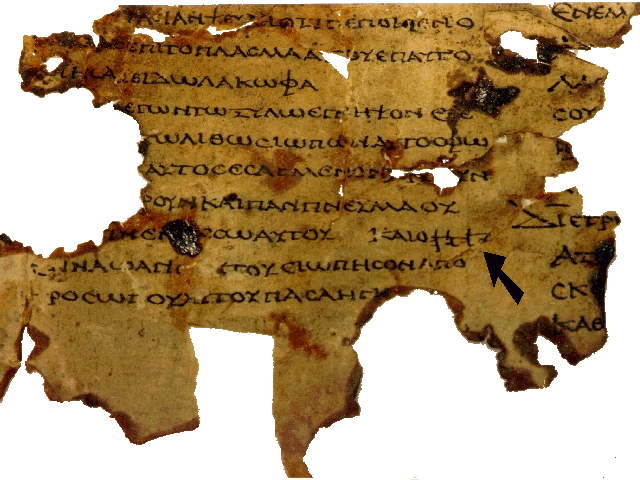
The Origin of the Old Testament Apocrypha
- The Apocrypha is a group of Jewish religious works written between 300 BC and 100 AD. It contains twelve writings that have a link to Bible events or people (1,2 Esdras, Tobit, Judith, Additions to Esther, Additions to Daniel, Wisdom of Solomon, Ben Sirach, Baruch, The Prayer of Manasseh, 1,2 Maccabees).
- Though many Jews knew and read the Apocrypha, they never thought of it as “the Word of God” and therefore did not consider it as authoritative. It was never considered part of the Old Testament Canon.
- When the Septuagint was translated in 250 BC, the Apocryphal books were also translated and added to the Old Testament translation as an appendix.
- It is interesting that Jesus, who quotes almost every book of the Old Testament, never once quotes from the Apocrypha. This stark contrast clearly shows that Jesus considers the Old Testament authoritative “Word of God”, but not the Apocrypha.
- In 400 AD church father Jerome translated the Bible into Latin. This translation is called the “Vulgata”. For the translation of the Old Testament, he used the text of the Septuagint. In this way together with the the authoritative Old Testament books the Apocrypha was also translated and added to the Vulgata.
- The church fathers Jerome, Origen, Cyril of Jerusalem, Athanasius and others all agreed with the Jews that the Apocrypha had only limited authority.
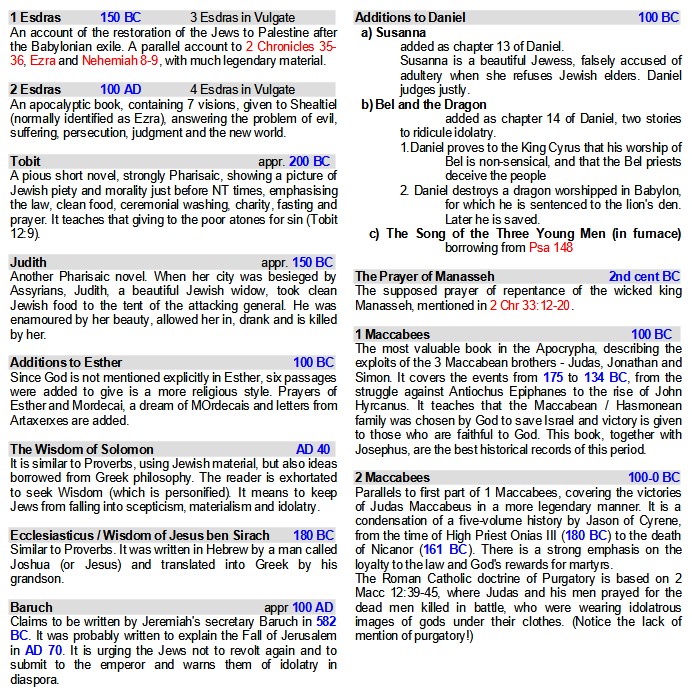
- The Old Testament Apocrypha was elevated to the status of ‘fully inspired Scripture’ by the Roman Catholic church at the counter-reformation Council of Trent as late as 1546 AD.
- The reformed church from the beginning rejected the Apocrypha.
- In this way it happened that the Apocryphal books are found in the Catholic Bible, but not in the Protestant Bibles.
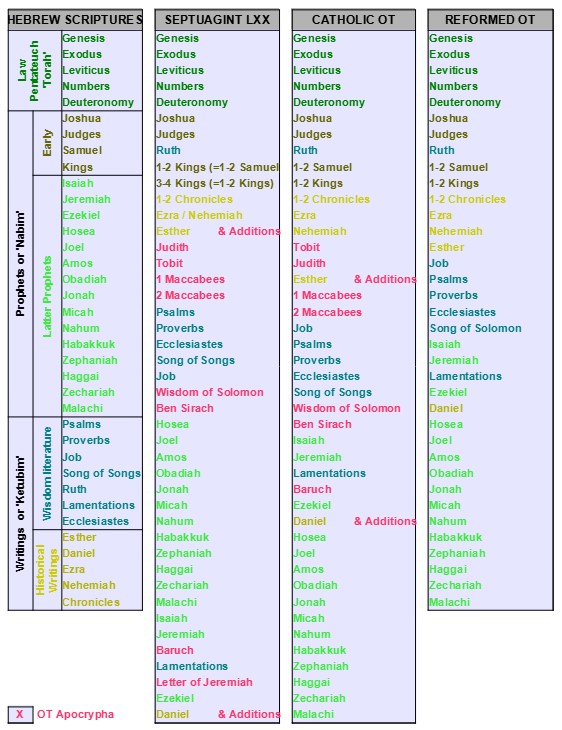
The Chart on the left shows the Bible books contained in the four collections, as well as their sequence:
- 1 Hebrew Scriptures (finalized about 450 BC)
- 2 Septuagint (Greek translation of the OT, 250 BC, Bible books rearranged and Apocrypha added)
- 3 Catholic Old Testament (Latin Vulgata translation of the OT, 400 AD, arranged as Septuagint)
- 4 Protestant Old Testament (current form, no apocryphal books).
The Formation of the New Testament Canon
- The early church understood the Old Testament to be God’s inspired writings, highly regarded them, continually quoted them.
- They also considered Jesus and the church the fulfilment of the prophecies in the Old Testament. For example:
- 2 Tim 3:16 “All scripture is inspired by God and is useful for teaching, for reproof, for correction, and for training in righteousness.”
- When first New Testament letters and gospels were written, they were understood to be equally authoritative to the Old Testament. For example Peter says:
- 2 Pet 3:15-16 “So also our beloved brother Paul wrote to you … there are some things in them hard to understand, which the ignorant and unstable twist to their own destruction, as they do the other scriptures.” Clearly Peter is regarding Paul’s writings as “scripture”.
- 2 Pet 1:20-21 “First of all you must understand this, that no prophecy of scripture is a matter of one’s own interpretation, because no prophecy ever came by human will, but men and women moved by the Holy Spirit spoke from God.”
- As New Testament letters and gospels were written, each church wanted to have copies of letters addressed to other churches. Paul openly encouraged the exchange of his letters (Col 4:16).
- Soon collections of Scripture sprung up in many places.
- Most scholars believe that Paul’s letters (the so-called “Pauline corpus“) were collected together and quite widely distributed by AD 85.
- The 4 gospels appear as a collection as early as AD 150.
- The oldest manuscripts for the NT are dated 96 and 125 AD. which means we still have manuscripts that were written within the lifetime of people who had personally known Jesus or had been discipled by apostles.
- Picture right: Chester-Beatty Papyrus, 200 AD, containing part of Philippians, beginning of Colossians.
- The New Testament as we have it appears as a collection as early as 170 AD (only 4 letters were not yet added: Hebrews, James, 1 & 2 Peter).
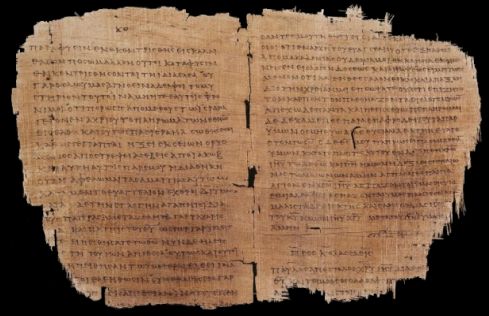
Criteria for Canonization
- As the church battled with heresy they perceived the need to define the writings considered authoritative and the need for an officially approved New Testament Canon became clear.
- What were the criteria for a writing to be considered NT Canon?
- apostolic authority. The book had to be written
- by first hand witnesses 12 apostles, like Matthew, John
- by apostles like Paul, who had direct authority from the risen Lord Jesus (Gal 1:16, 1 Cor 14:37)
- or from immediate followers and long-term co-workers, like Mark or Luke.
- Consistency with the Old Testament canon books
- Consistency with other authoritative New Testament writings, it had to be accepted doctrine.
- Proven usefulness in practical use by churches. It had to be proven as the practical, God-breathed, life-changing Word of God.
- It required total agreement by the church, its fathers and leaders as expressed in church councils)
- apostolic authority. The book had to be written
- It is amazing that the Bible Canon has been agreed over and undisputed over many centuries … by a church that usually can’t agree on anything!
- The Holy Spirit is the one that inspired the writers so that their writings are the “Word of God”
- The Holy Spirit is the one who lead the church fathers in their selection and recognition of the authority of the Scriptures.
- It is not really right to say that the councils authorize writings as Scripture.
- It is rather that the councils recognized an Inspiration by God through the Holy Spirit that these writings already had.
- Also consider that the Bible has survived tremendous persecutions (for example in 303 AD by Emperor Diocletian with a command to burn all scriptures). People in various centuries have been willing to lay down their lives and have indeed died for this canon.
- In the table below quotations and authorizations of New Testament books are shown. Also early collections and church councils are shown.
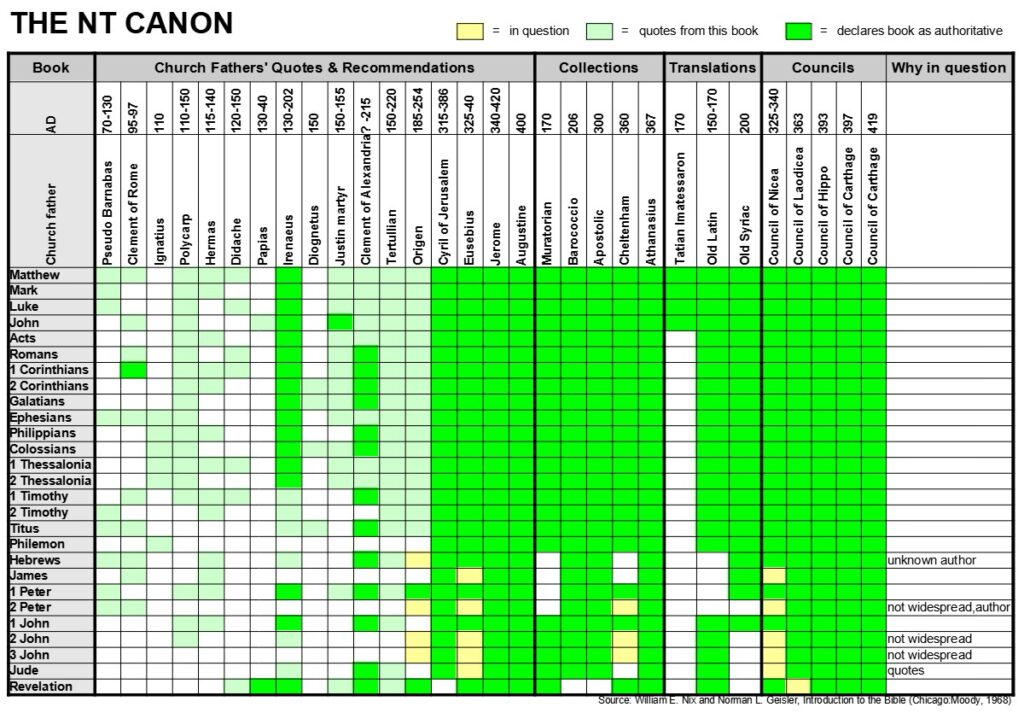
New Testament Apocrypha
- NT Apocrypha are writings by Christian authors from 100-400 AD.
- Both Catholics and Protestants never considered them ‘Word of God’ or authoritative.
- They were never considered Canon, though many thought them useful writings like we might appreciate Oswald Chambers “My utmost for his highest” or other devotional books.
Pseudo-Epigrapha
- In contrast to the New Testament Apocrypha, which were widely accepted texts, the meaning of the word “Pseudo-Epigrapha” in Greek means “false writings”.
- A writer takes up a pseudonyms (a famous person in the remote past, like Henoch) and writes imaginary stories around that person.
- The Pseudo-Epigrapha are Jewish religious works written between 200 BC and 200 AD.
Preservation of Manuscripts
- Let’s say we accept the books of the New Testament as the inspired “Word of God”. But can we be sure that the texts we find in our modern Bibles is what Peter, Paul, Matthew etc. actually wrote?
- This is a question not of inspiration or authority, but of Manuscript Preservation.
- In answer it can be said that the oldest manuscripts for the New Testament are dated 96 and 125 AD, that is within the lifetime of people who had personally known Jesus or known the apostles.
- This means for the New Testament writings the gap between the original writing and the oldest available manuscripts or pieces of manuscripts is as little as say 40 years.
- How does this compare with other writings (for example documents that were preserved from Roman emperors, Roman historians and the like)?
- In the following table some of these other writings are compared with the New Testament writings. Please consider the information carefully:
Author (Title of Work) | When written | Earliest Copy | Time Span elapsed | No of manuscripts found |
Caesar Julius “de bellum Gallicum” | 100-44 BC | 900 AD | 1000 y | 10 |
Livy “History of Rome” | 59 BC-17 AD | 900 AD | 1200 y | 20 |
Plato “Tetralogies” | 427-347 BC | 1100 AD | 1000 y | 7 |
Tacitus “Annals” | 100 AD | 1000 AD | 900 y | 20 |
Pliny the Younger “History” | 61-113 AD | 850 AD | 750 y | 1 |
Thucydides “History” | 460-400 BC | 900 AD | 1300 y | 7 |
Suetonius “De Vitae Caesarum” | 75-160 AD | 950 AD | 800 y | 8 |
Herodotus | 480-425 BC | 900 AD | 1330 y | 8 |
Homer “Illiad” | 900 BC | 400 BC | 500 y | 643 |
NT | 47-96 AD | 125 AD | 29 y | more than 24’000 |
- The New Testament’s oldest full witness is the Codex Sinaiticus, a uncial written about 350 AD. It is the earliest extant copy of the entire New Testament.
- Other uncials, such as the Codex Vaticanus, Alexandrinus, Ephraemi and Bezae constitute significant witnesses as well.
- In addition to this the Church Fathers’ writings provide helpful early attestation with 36’000 New Testament quotes in the works of 9 major Church Fathers.
- The total of quotes according to Josh Mc Dowell website 2014 is 68’000 quotes.
- The early church father’s writings (2 & 3rd century) quote so much from the New Testament (and quote consistent with the New Testament text we consider authoritative) that all but 11 verses of the New Testament appear.
Summary
- In summary it can be said that the New Testament remains the best attested document of the ancient world.
- There are 6000 Greek manuscripts (papyrus fragments, unicals, minuscules), over 10’000 Latin Vulgate manuscripts, and more than 9’300 early translation versions, so in total 25’000 witnesses to the New Testament text, with almost a 100% match in accuracy.
- Other writings of that area (see list) are dated to 500-1600 years after the writing of the original, most only appearing in the middle ages.
- There are over 37x more manuscripts of the NT than of the next common work (Homer’s Iliad). There are 200x more manuscript-evidence for the existence of Jesus than of Julius Caesar.
- Over 24’000 New Testament manuscripts and New Testament fragments have been found, matching virtually 100%.
- In the writings of 9 church fathers alone are another 36’000 quotes of NT Bible verses, matching the manuscripts.
- No other work of Antiquity has anywhere near as good and early attestation than the NT.